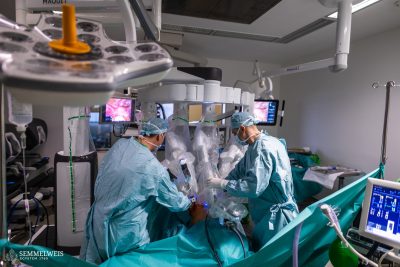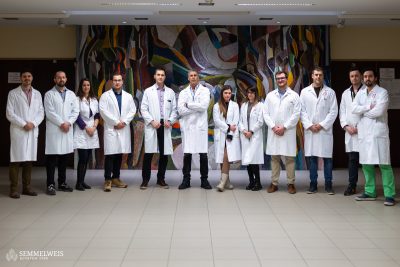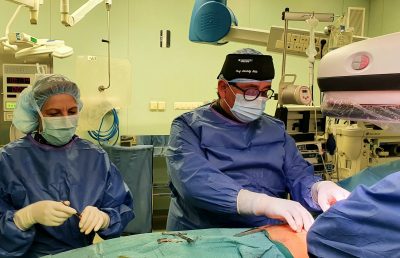Dr. Péter Mátyus, former director for scientific affairs, has been appointed managing director of the Bionic Innovation Centre Ltd. starting from May 1, 2016, and Dr. Károly Rácz has taken over the responsibilities of the director for scientific affairs. The Centre built in the framework of the collaboration between Semmelweis University and Péter Pázmány Catholic University is located in the 8th district in Balassa street.
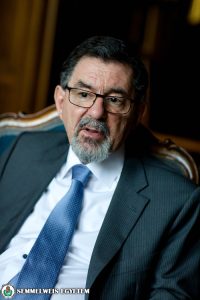 “The foundation stone of the Centre was laid down last year in March, but the collaboration between Semmelweis University and Péter Pázmány Catholic University, especially with the Faculty of Information Technology and Bionics, has started a few years earlier. There were several programmes, including a PhD conference in bionics, that were mutually organised by the two institutions.”, said Rector Dr. Ágoston Szél.
“The foundation stone of the Centre was laid down last year in March, but the collaboration between Semmelweis University and Péter Pázmány Catholic University, especially with the Faculty of Information Technology and Bionics, has started a few years earlier. There were several programmes, including a PhD conference in bionics, that were mutually organised by the two institutions.”, said Rector Dr. Ágoston Szél.
Rector Szél is very proud of the strong partnership between the two universities, which was the basis for launching this new endeavour. He recalled that the establishment of this Centre was initiated by the founder of the Faculty of Information Technology and Bionics of Péter Pázmány Catholic University, Dean, Dr. Tamás Roska, who passed away in 2014. For the sake of the realisation of this project the Centre was founded by the two universities, and for this a financial support of 5 billion HUF was granted by the government from the Research and Technological Innovation Fund.
According to Rector Szél the development of the Centre is equally important to that of Korányi Project, in the framework of which patient care has been recently started at the Central Health Care Building. Due to this progress a 21st century research infrastructure was built only a few blocks away from the modern hospital building.
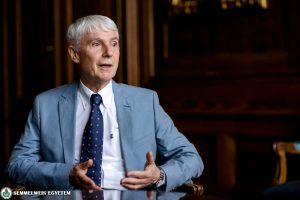 ” I started to work as managing director in a very active period of the project. We are working intensively on the pre-arrangements of the constructions, which will commence this year. The construction of the building (5000 square meters) will expectedly be finished by the end of 2017, and by then the scientific contents need to be established as well. In the framework of the Centre research is already in progress, mostly with the participation with the two universities. The majority of the projects currently focuses on the extended field of medicinal diagnostics, where both sides of diagnostics are being dealt with: the research and application of biomarkers (the informative parameters related to the disease, biological indicators), and the development of modern diagnostic equipment.”, said Dr. Péter Mátyus, who was director of the Department of Organic Chemistry at the Faculty of Pharmaceutical Sciences for 19 years until he was appointed managing director of the Centre.
” I started to work as managing director in a very active period of the project. We are working intensively on the pre-arrangements of the constructions, which will commence this year. The construction of the building (5000 square meters) will expectedly be finished by the end of 2017, and by then the scientific contents need to be established as well. In the framework of the Centre research is already in progress, mostly with the participation with the two universities. The majority of the projects currently focuses on the extended field of medicinal diagnostics, where both sides of diagnostics are being dealt with: the research and application of biomarkers (the informative parameters related to the disease, biological indicators), and the development of modern diagnostic equipment.”, said Dr. Péter Mátyus, who was director of the Department of Organic Chemistry at the Faculty of Pharmaceutical Sciences for 19 years until he was appointed managing director of the Centre.
As Dr. Péter Mátyus expressed, one of the basic goals of the research is to find such biomarkers, which indicate the period before a disease emerges (pre-disease) when the process is still reversible, so there is a chance for a real intervention. As an example, Dr. Mátyus mentioned the neurodegenerative diseases, which can be a serious burden for the aging society, as after the appearance of the typical symptoms usually only the treatment of the symptoms can be accomplished successfully in most of the cases.
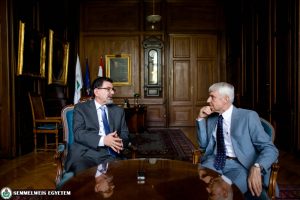 “Another aspect of the application of biomarkers is ensuring the appropriate and objective monitoring in order to be able to optimalise the therapy. It is one of the goals of the project to take the diagnostic equipment right to the hospital bed. With such, so called point-of-care devices doctors at the emergency care have the opportunity for an efficient intervention on the basis of the diagnostic information, and thus to be able to start the required therapy. Apart from this, mobile devices can play an important role in patient care, and also in the home monitoring of patients with chronic diseases.”, expressed Dr. Péter Mátyus.
“Another aspect of the application of biomarkers is ensuring the appropriate and objective monitoring in order to be able to optimalise the therapy. It is one of the goals of the project to take the diagnostic equipment right to the hospital bed. With such, so called point-of-care devices doctors at the emergency care have the opportunity for an efficient intervention on the basis of the diagnostic information, and thus to be able to start the required therapy. Apart from this, mobile devices can play an important role in patient care, and also in the home monitoring of patients with chronic diseases.”, expressed Dr. Péter Mátyus.
The Centre thus also provides the research and intellectual background for future medicine, and it is its mission to pull the relevant fields together, as well as to exploit the offered opportunities. Due to the project a Bionic Innovation Industrial Park will be established right next to the Centre, in which the research results and knowledge received from the Centre could be converted to innovative products. According to Dr. Péter Mátyus, the two universities, the Centre and the industrial park will create a unique base of research and innovation, a so-called bioinnopolis. Dr. Mátyus also emphasized that the enormous project could not have been realised without the devoted support of the rectors of both universities.
The word bionics was first used by an American aerospace engineer, John E. Steele in 1960, with the merging of the words bios and technics. Currently it is usually interpreted as the combination of the words biology, biomedicine, electronics and informatics.
Pálma Dobozi
Photo: Attila Kovács, Semmelweis University
Translation: Katalin Romhányi
